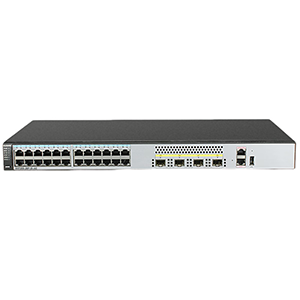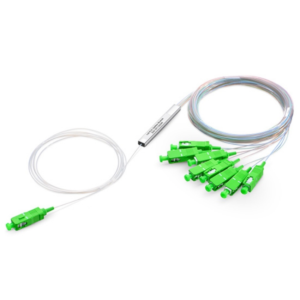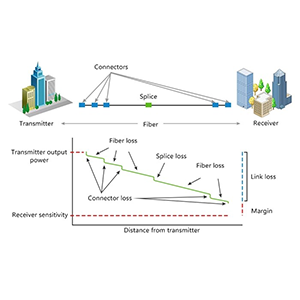As an important component in the field of optical fiber communications, fiber optic mux demux plays a key role in achieving efficient optical fiber transmission. This article will introduce the basic concepts and functions of fiber optic multiplexers and demultiplexers as well as their applications in fiber optic communication networks and data centers.
We will also delve into the principles of fiber multiplexing technologies, including wavelength division multiplexing (WDM) and dense wavelength division multiplexing (DWDM). Furthermore, we will explain how fiber optic multiplexers and demultiplexers work, as well as their performance parameters in terms of number of channels, signal transmission distance, etc. Finally, we will also provide considerations for installing and maintaining fiber optic multiplexers and demultiplexers to ensure their stable and reliable operation.
Fiber optic mux demux introduction
Definition and functions:
Fiber optic mux demux (multiplexer/demultiplexer) is an optical device used to multiplex and separate multiplexed signals in fiber optic communication systems. It can combine multiple optical signals into one optical fiber for transmission, or separate multiple signals on a single optical fiber to different receiving ends.
Fiber multiplexing technology:
Optical fiber multiplexing technology is a technology that realizes the simultaneous transmission of multiple signals by rationally utilizing the optical fiber transmission bandwidth. It uses equipment such as fiber optic mux demux to multiplex multiple signals, thereby improving the efficiency and capacity of the optical fiber transmission system.
principle:
The basic principle of optical fiber multiplexing technology is to use different optical wavelengths or time slots to distinguish and multiplex multiple signals. This allows multiple signals to be transmitted on the same optical fiber without interfering with each other.
The main fiber multiplexing technologies include:
-
Wavelength Division Multiplexing (WDM): WDM uses different optical wavelengths to multiplex multiple signals into optical fibers. It includes two types: dense wavelength division multiplexing (Dense WDM, DWDM) and wavelength division multiplexing (Coarse WDM, CWDM). DWDM uses very tight wavelength intervals in the optical fiber, which can achieve high-density signal multiplexing; CWDM uses wider wavelength intervals and is suitable for shorter distance transmission.
-
Time Division Multiplexing (TDM): TDM divides multiple signals into different time slots according to time and transmits them alternately on the optical fiber. The receiving end separates the signal based on time information. TDM is suitable for applications requiring real-time transmission, such as voice and video.
The role of optical fiber multiplexing technology:
Optical fiber multiplexing technology can improve the bandwidth utilization and transmission capacity of optical fiber communication systems, while reducing the number of optical fibers used. It can meet the needs of simultaneous transmission of different signals and provide high-speed, high-capacity and reliable communication services.
Fiber optic mux demux is one of the key devices for realizing optical fiber multiplexing technology. It can combine and separate multiple signals to achieve efficient transmission of optical fiber communication systems. Fiber multiplexing technology improves the efficiency and capacity of optical fiber transmission by multiplexing multiple signals in optical fibers by using different optical wavelengths or time slots.
Types of fiber optic mux demux
Wavelength Division Multiplexing (WDM):
Wavelength Division Multiplexing (WDM) is an optical fiber multiplexing technology that multiplexes multiple signals into optical fibers by using different optical wavelengths. In fiber optic mux demux, WDM technology is used to combine and separate optical signals of different wavelengths.
In a fiber optic multiplexer (mux), WDM technology combines multiple input optical signals, each encoded using a different wavelength, into a single fiber for transmission. A fiber optic multiplexer has multiple input ports and one output port, with each input port corresponding to a specific wavelength. WDM technology allows these signals to be transmitted simultaneously in the optical fiber, thereby improving the bandwidth utilization of the optical fiber.
In a demultiplexer (demux), WDM technology is used to separate multiple signals on an optical fiber to different receiving ends. A demultiplexer has an input port and multiple output ports, each output port corresponding to a specific wavelength. WDM technology realizes signal separation and transmission by selectively separating optical signals of specific wavelengths and sending them to corresponding receivers.
Dense Wavelength Division Multiplexing (DWDM):
Dense Wavelength Division Multiplexing (DWDM) is a high-density wavelength division multiplexing technology that uses very close wavelength intervals in optical fibers to multiplex more signals. Compared with traditional WDM technology, DWDM technology has smaller wavelength intervals and can transmit more signals at the same time.
DWDM technology is widely used in high-capacity optical fiber transmission. It can transmit dozens or hundreds of optical signals of different wavelengths on one optical fiber to achieve very high signal density. This makes DWDM an ideal choice for long-distance, high-capacity optical fiber transmission, such as long-distance optical fiber communications, optical fiber backbone networks, and data center interconnections.
The key to DWDM technology is the ability of fiber optic multiplexers and demultiplexers to accurately combine and separate signals at very short wavelength intervals. At the same time, DWDM systems also use fiber amplifiers to enhance signal transmission distance and quality. Through DWDM technology, optical fiber transmission systems can achieve greater bandwidth capacity and longer transmission distances to meet the growing communication needs.
How fiber optic mux demux works
Reuse process:
A fiber optic multiplexer (mux) works by combining multiple signals into a single fiber for transmission. The following is the detailed working process of the fiber multiplexer:
-
Input signal preparation: Each input signal needs to go through a modulation and encoding process in order to be distinguished using different wavelengths in the optical fiber. Each input signal is modulated to a specific wavelength, typically using a laser to generate the corresponding optical signal.
-
Optical wavelength alignment: In optical fiber multiplexers, optical wavelength alignment is a key step. The wavelengths of different input signals need to be precisely aligned so that they can be combined into the same fiber. This is usually achieved using elements such as gratings or interferometers.
-
Combined signals: Combined signals refer to combining wavelength-aligned optical signals into a single optical fiber. This process is usually achieved using components such as gratings or fiber optic couplers. The combined optical signals are transmitted simultaneously in the optical fiber, and the individual signals will not interfere with each other.
Demultiplexing process:
The working principle of the demultiplexer (demux) is to separate the combined signals on the optical fiber so that they can be received by different receiving ends. Here is how the demultiplexer works:
-
Optical signal separation: After the combined optical signal enters the demultiplexer, optical signal separation needs to be performed. This process is usually achieved using components such as gratings or fiber optic couplers. A grating or fiber optic coupler selectively separates individual signals into different output ports based on their wavelength.
-
Output signal processing: The separated signals are transmitted to the corresponding receiver or processor through the output port. At the receiving end, the signal needs to be demodulated and decoded to recover the original data or information.
A fiber multiplexer (mux) works by combining multiple signals into a single fiber, which includes steps such as input signal preparation, optical wavelength alignment, and combining the signals. The working principle of the demultiplexer (demux) is to separate the combined signals, including processes such as optical signal separation and output signal processing. The synergy of these steps and components enables fiber optic multiplexers and demultiplexers to multiplex and separate signals, improving the efficiency and capacity of fiber optic communication systems.
Application fields of fiber optic mux demux
Optical communication network:
Fiber optic mux demux plays a key role in optical communication networks. The following are its applications in optical communication networks:
-
Improvement of optical fiber transmission capacity: By using optical fiber multiplexers (mux) and demultiplexers (demux), multiple signals can be transmitted on the same optical fiber, thereby increasing the optical fiber transmission capacity. This can make full use of the bandwidth of optical fiber to meet the growing communication needs.
-
Long-distance communication: Fiber optic multiplexers and demultiplexers extend the transmission distance of optical signals. Through wavelength division multiplexing (WDM) and dense wavelength division multiplexing (DWDM) technologies, multiple signals can be transmitted simultaneously on optical fibers to achieve long-distance communications, such as optical fiber backbone networks and submarine optical cables.
-
Network topology flexibility: The application of optical fiber multiplexers and demultiplexers makes the topology of optical communication networks more flexible. They allow cross-connections between different fiber optic links, allowing for more efficient signal routing and network management.
data center:
Fiber optic mux demux is also widely used in data centers to improve bandwidth utilization and data transmission efficiency. Here are its applications in data centers:
-
High-density data transmission: Data centers need to handle a large amount of data traffic, and fiber optic mux demux can combine multiple optical signals into a single optical signal through wavelength division multiplexing (WDM) and dense wavelength division multiplexing (DWDM) technology. Transmitted in optical fiber. This enables high-density data transmission and increases the overall bandwidth of the data center.
-
Fast data exchange: Fast and efficient data exchange is required between servers and storage devices in the data center. By using fiber optic mux demux, different data traffic can be allocated to different fiber channels to achieve parallel transmission and improve the speed and efficiency of data exchange.
-
Network expansion and upgrade: As the scale of data centers expands and business needs increase, network expansion and upgrade become critical. Fiber optic mux demux enables networks to be expanded and upgraded to accommodate growing data demands by increasing the number of fiber channels or utilizing tighter wavelength spacing.
Fiber optic mux demux has important applications in optical communication networks and data centers. In optical communication networks, they increase fiber transmission capacity, enable long-distance communications, and increase network flexibility. In data centers, they improve bandwidth utilization, enable high-density data transmission and fast data exchange, while also providing flexibility and reliability for network expansion and upgrades.
Performance parameters of fiber optic mux demux
Number of channels:
The number of channels in a fiber optic mux demux depends on its design and application requirements. They can support varying numbers of channels and are typically implemented with wavelength division multiplexing (WDM) or dense wavelength division multiplexing (DWDM) technology. Here are some common channel number ranges and wavelength ranges:
-
WDM system: In WDM system, a small number of channels are usually used, such as 8 or 16 channels. The wavelength of each channel is typically in the C-band (1525 nm to 1565 nm) or L-band (1570 nm to 1610 nm) range.
-
DWDM system: In a DWDM system, more channels are usually used, such as 40, 80 or more. The wavelength range of each channel is denser, usually within the C-band or L-band, and the wavelength spacing can reach 0.8 nm or less.
It is important to note that the number of channels and wavelength range are determined based on the specific fiber multiplexer and demultiplexer design and specifications. Different systems and vendors may offer different channel numbers and wavelength range options.
Signal transmission distance:
The signal transmission distance of fiber optic mux demux is affected by fiber attenuation and other factors. The following are the main performance parameters related to signal transmission distance:
-
Fiber attenuation: Attenuation in optical fibers limits the distance that signals can be transmitted. Fiber attenuation is usually expressed in terms of unit distance (such as attenuation per kilometer), and the common attenuation range is 0.2 dB/km to 0.5 dB/km.
-
Fiber gain attenuation characteristics: Signals in optical fibers will encounter gain and attenuation during transmission. The design of fiber optic mux demux needs to consider and compensate for these gains and attenuations to ensure the quality and stability of the signal during transmission.
-
Relay equipment: For long-distance transmission, relay equipment such as fiber amplifiers or fiber regenerators may be needed to enhance and restore signal quality to extend the signal transmission distance.
It should be noted that the signal transmission distance is also affected by other factors, such as the quality of the optical fiber, the loss of the connector and interface, etc. In practical applications, these factors need to be considered comprehensively to determine the signal transmission distance limit and gain attenuation characteristics of fiber optic mux demux.
Installation and maintenance precautions for fiber optic mux demux
Installation and connection:
When installing fiber optic mux demux, here are some considerations and steps:
-
Determine the correct location: Choose an appropriate location to install the fiber optic mux demux so that it is convenient for connecting fiber optics and other equipment.
-
Optical fiber connection: Connect the optical fiber to the input and output ports of the fiber optic mux demux using appropriate fiber optic connectors and connection methods. Make sure the connectors are clean and properly aligned to avoid signal loss and bad connections.
-
Optical power calibration: Calibrate and test the optical power before connecting the optical fiber. Make sure that the input and output optical powers are within the normal range to ensure the quality of signal transmission.
-
Power supply connection: According to the equipment requirements, correctly connect the fiber optic mux demux to the power supply.
Maintenance and troubleshooting:
Maintenance and troubleshooting of fiber optic mux demux requires some professional knowledge and skills. Here are some maintenance points and troubleshooting tips:
-
Regular cleaning: Regularly clean the connectors and ports of the fiber optic mux demux to remove dust, dirt and other impurities. Use appropriate fiber cleaning tools and solutions for cleaning, and avoid using rough materials that can damage the fiber surface.
-
Signal test: Conduct signal test regularly to ensure that the input and output optical power and signal quality are within the normal range. Use test equipment such as optical power meters and spectrometers to conduct tests, and record test results for comparison and analysis.
-
Fault diagnosis: If signal transmission interruption, optical power abnormality or other faults occur, perform step-by-step fault diagnosis. Check fiber optic connectionconnections, connectors, power supplies, etc., and eliminate possible problems based on fault symptoms and test results.
-
Technical support: If you encounter complex faults or require professional maintenance, seek support and help from suppliers or professional technicians. They can provide further troubleshooting and repair advice.
It should be noted that for the maintenance and troubleshooting of fiber optic mux demux, relevant safety procedures and operating guidelines need to be followed to ensure the safety of personnel and equipment. Always disconnect power and follow correct operating procedures before performing any maintenance operations.
Summarize:
As a key component of optical fiber communications, optical fiber multiplexers and demultiplexers provide an effective solution for achieving high-speed, high-bandwidth data transmission. Through optical fiber multiplexing technology, multiple signals can be transmitted on the optical fiber at the same time, greatly improving the capacity and utilization of the optical fiber network. Fiber optic multiplexers and demultiplexers are widely used in optical communication networks and data centers, providing strong support for information transmission in various industries.
When installing and maintaining fiber optic multiplexers and demultiplexers, be sure to follow correct operating methods and perform regular maintenance and troubleshooting to ensure stable and reliable performance. With the continuous development of technology, optical fiber multiplexers and demultiplexers will continue to play an important role in the field of optical fiber communications, promoting further innovation and improvement of information transmission.




